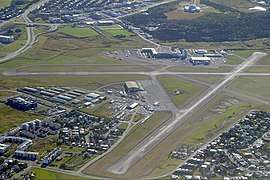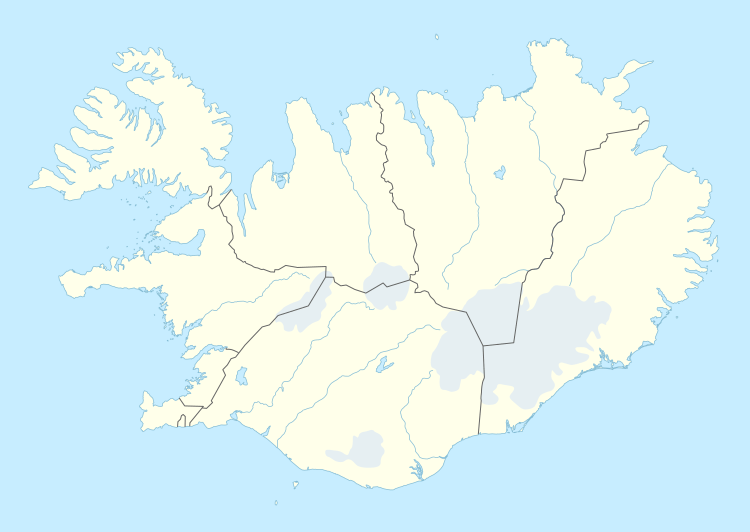Reykjavík Airport
Reykjavík Airport (Icelandic: Reykjavíkurflugvöllur) (IATA: RKV, ICAO: BIRK) is the main domestic airport serving Reykjavík, the capital of Iceland, located about 2 kilometres (1.2 mi) from the city centre. Having shorter runways than the city's bigger Keflavík International Airport, which is sited 50 kilometres (31 mi) out of town, it only serves internal flights within Iceland and to Greenland, small international charters, transatlantic ferry flights and private flights. It can also serve as alternate airport for flights inbound towards Keflavík, in case of adverse weather conditions there. To distinguish from the larger Keflavík International Airport outside Reykjavík, it is sometimes unofficially in English called Reykjavik City Airport (also by the airport administration),[5] and also Reykjavik Domestic Airport,[6] but also Reykjavík international Airport[7] because it has some international flights but mostly domestic ones.
Reykjavík Airport Reykjavíkurflugvöllur | |||||||||||||||||||
|---|---|---|---|---|---|---|---|---|---|---|---|---|---|---|---|---|---|---|---|
 | |||||||||||||||||||
 | |||||||||||||||||||
| Summary | |||||||||||||||||||
| Airport type | Public | ||||||||||||||||||
| Owner | Isavia | ||||||||||||||||||
| Serves | Reykjavík, Iceland | ||||||||||||||||||
| Elevation AMSL | 44 ft / 14 m | ||||||||||||||||||
| Coordinates | 64°07′48″N 021°56′26″W | ||||||||||||||||||
| Website | isavia.is | ||||||||||||||||||
| Map | |||||||||||||||||||
 RKV Location of Airport in Iceland | |||||||||||||||||||
| Runways | |||||||||||||||||||
| |||||||||||||||||||
| Statistics | |||||||||||||||||||
| |||||||||||||||||||
Reykjavík Airport is the main hub of Air Iceland Connect and Eagle Air. Of the airport's three runways, two are currently active all-year round. The shortest runway, 06/24, is usually used only in winter, and takeoffs from 06 (northeast direction) are forbidden because of safety and noise. Reykjavík Airport is owned and operated by the state enterprise Isavia.
History
_CS64_(cropped).jpg)
The first flight from the airport area was 3 September 1919, with the takeoff of an Avro 504, the first aeroplane in Iceland. Until 1937, there were experiments with airline operations in Vatnsmýri, but with the foundation of Iceland's oldest airline, Flugfélag Akureyrar (now Icelandair) in Akureyri in 1938, operations began in the area and in March 1940 scheduled flights started when Flugfélag Akureyrar moved its hub from Akureyri to Reykjavík (and changed its name to Flugfélag Íslands).
The current airport was built by the British Army during World War II on the south coast of the Reykjavík peninsula. Construction began in October 1940, when the airport had only a grass surface. The Black Watch regiment built the first runway, constructing it over sunken oil barrels. The British Royal Air Force operated from the airport, then named RAF Reykjavik, from March 1941. On 6 July 1946, the British handed the airport operation over to the Icelandic government and since then it has been operated by the Icelandic Civil Aviation Authority (now Flugstoðir).
Renovation of the airport started in 2000 and lasted two years. This was followed by a referendum in 2001, with 49.3% of the votes for moving the airport out of the city centre, and 48.1% votes for it remaining in place until 2016, when the current urban plan expires. The outcome of these elections on the other hand was not binding because election participation was under 40% and the left wing majority made the decision to have such a clause for it to be binding and beyond that because these elections were not held properly in respect to certain legal technicalities that also resulted in no option for non-election day voting (for vacationers for example).
After renovation, the width of runways 01/19 and 13/31 are 45 m and 06/24 is 30m, with visual approach for runways 01 and 31, while runway 19 has ILS CAT I/NBD-DME approach and runway 13 has LLZ-DME/NDB-DME approach. The lights for the runways were updated with LIH Wedge for all runways.
Future
The city has grown around the airport and it is now located in the western part of the city. This location is considered inconvenient by many, for noise and safety reasons and because it takes up a lot of otherwise useful area near downtown areas. There is an ongoing debate about the future of the airport, with the three options being: Leaving the airport as is, demolishing the airport and building a new airport elsewhere in the Reykjavík area or demolishing the airport and moving all flight services to Keflavík.
Facilities
There are two terminals located on different sides of the runway area: the main terminal (64°7′54″N 21°56′47″W) handles both international and domestic traffic for Air Iceland, and a smaller terminal (64°7′46″N 21°55′59″W) which serves domestic and international business flights for Eagle Air.
Airlines and destinations
| Airlines | Destinations |
|---|---|
| Air Iceland Connect | Akureyri, Egilsstaðir, Ísafjörður, Kulusuk, Nuuk Seasonal: Ilulissat, Narsarsuaq |
| Eagle Air | Bíldudalur, Gjögur, Húsavík, Höfn, Vestmannaeyjar |
Other facilities
Icelandair Group and Icelandair have a head office at the airport.[8] Air Iceland and Isavia also have their head offices on the airport property.[9][10] When Loftleiðir was in operation, its head office was at the airport.[11]
Ground transportation
There are some local city buses at both terminal buildings.
BSÍ, located near the airport, 1.6 km (1.0 mi) from the main airport terminal, is a major bus terminal. At the bus terminal, Strætó bs provides bus service to areas around Reykjavik while Gray Line Iceland Excursions' Airportexpress and Reykjavik Excursions Kynnisferðir's Flybus services connect between Keflavík International Airport and Reykjavik Airport. When changing between domestic and international flights a 50 km bus transfer between Reykjavík Airport and Keflavík International Airport is usually needed, and at least three hours between flights is recommended.
Accidents and incidents
- On 27 December 1980, Douglas C-47B N54605 of Visionair International was damaged beyond repair in a storm at Reykjavik Airport.[12]
- On 7 August 2000, a Cessna T210L Centurion II with the registration TF-GTI was on its way from Vestmannaeyjar (BIVM/VEY) to Reykjavik (BIRK/RKV) with six people onboard experienced an engine failure and stalled into the Skerjafjörður inlet
References
- https://www.isavia.is/media/1/12-2018-tolur-fyrir-vefsiduna.pdf
- https://www.isavia.is/media/1/12-2018-tolur-fyrir-vefsiduna.pdf
- BIRK AIP from the Icelandic CAA Archived 2015-04-02 at the Wayback Machine
- Aviation Fact File 2011 from Isavia
- Reykjavik City Airport
- Car Rental in Reykjavik Domestic Airport
- Reykjavik International Airport Live Arrivals
- "Location Archived 2009-06-21 at the Wayback Machine." Icelandair Group. Retrieved on 28 December 2009.
- Home. Air Iceland. Retrieved on 13 February 2011. "© Air Iceland - Reykjavik airport - 101 Reykjavik"
- "Home." Isavia. Retrieved on 9 September 2010. "Isavia · Reykjavik Airport"
- "World Airline Directory." Flight International. 13 April 1967. 578. "Head Office: Reykjavík Airport, Iceland."
- "N54605 Accident description". Aviation Safety Network. Retrieved 24 July 2010.
External links
![]()
- Reykjavík Airport at Isavia (in English)
- Reykjavík Airport at the Icelandic Civil Aviation Administration (in English)
- Reykjavík Airport at the Icelandic Civil Aviation Administration (in Icelandic)
- Airport information for BIRK at World Aero Data. Data current as of October 2006.